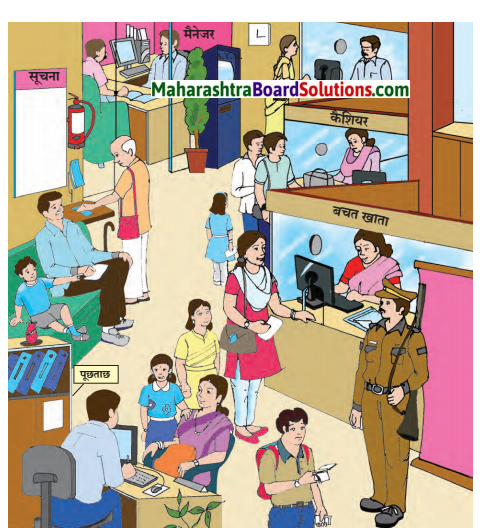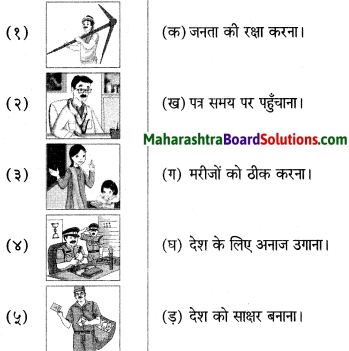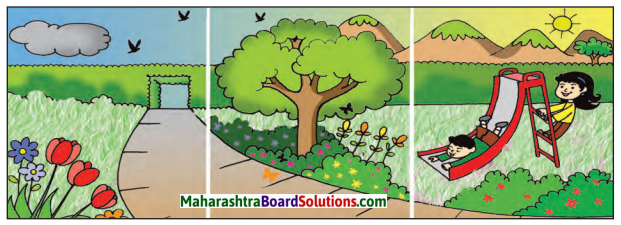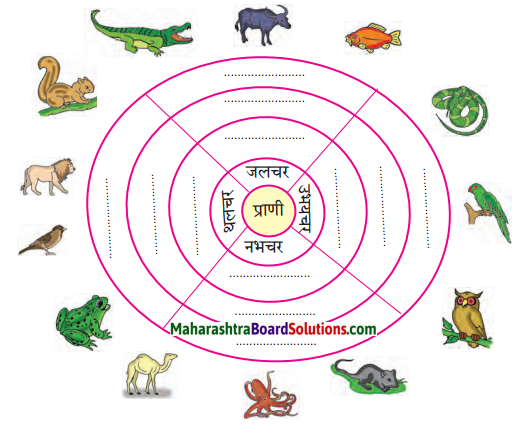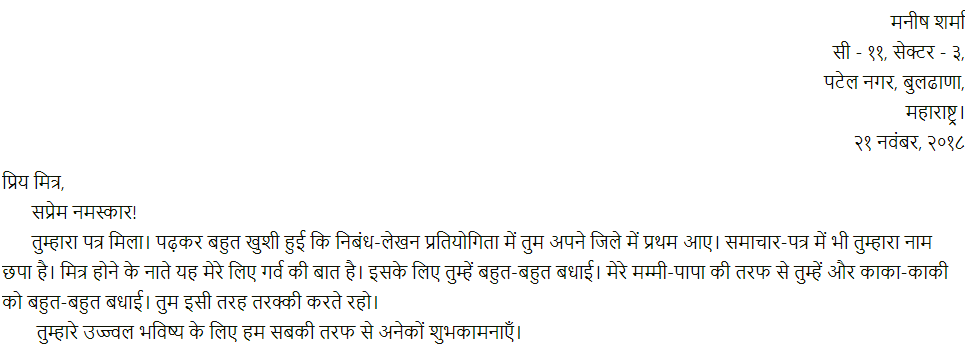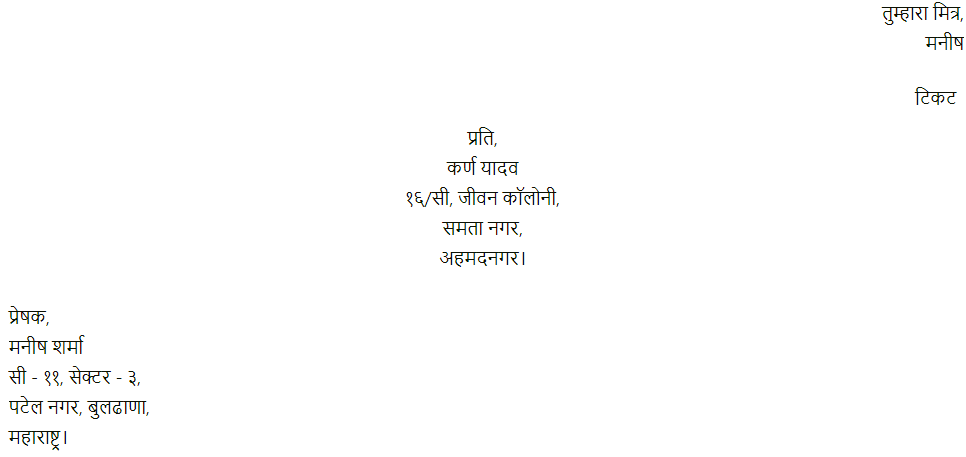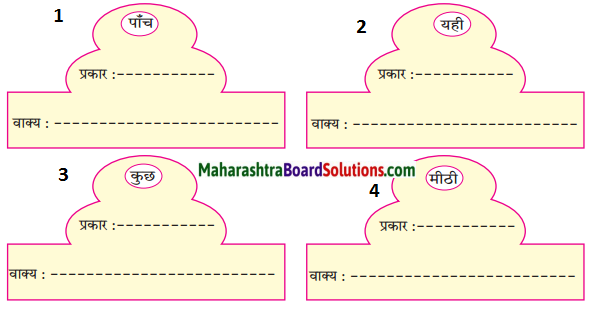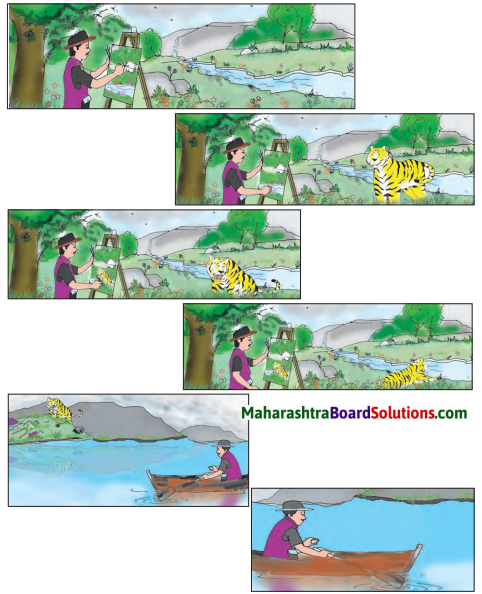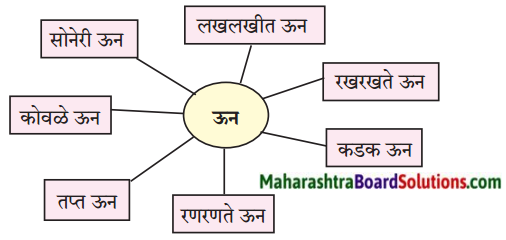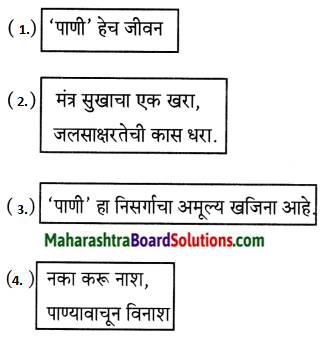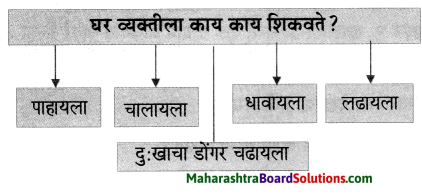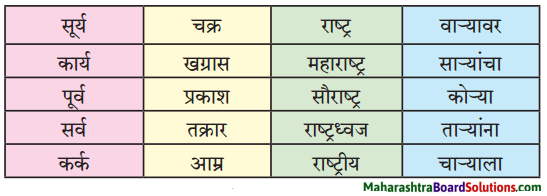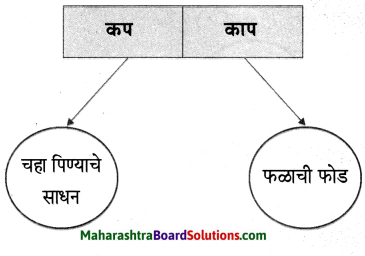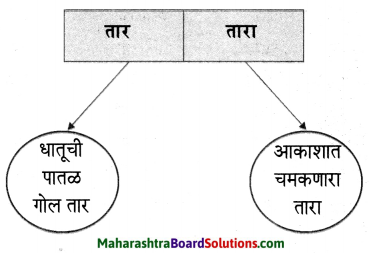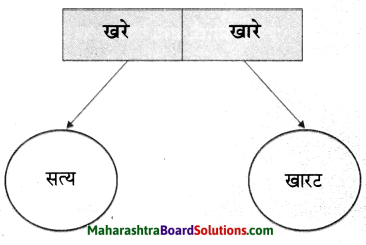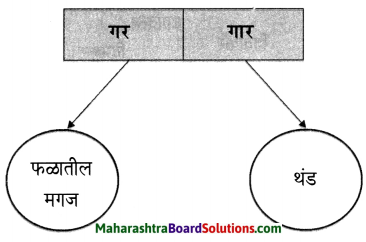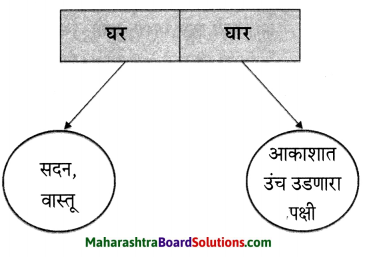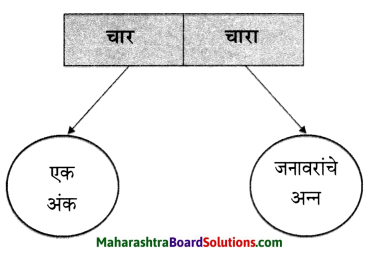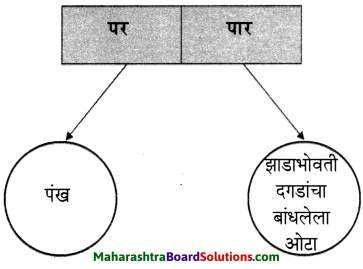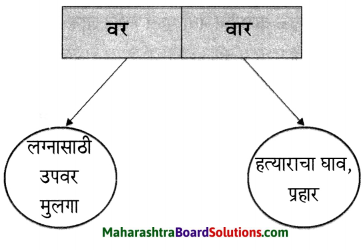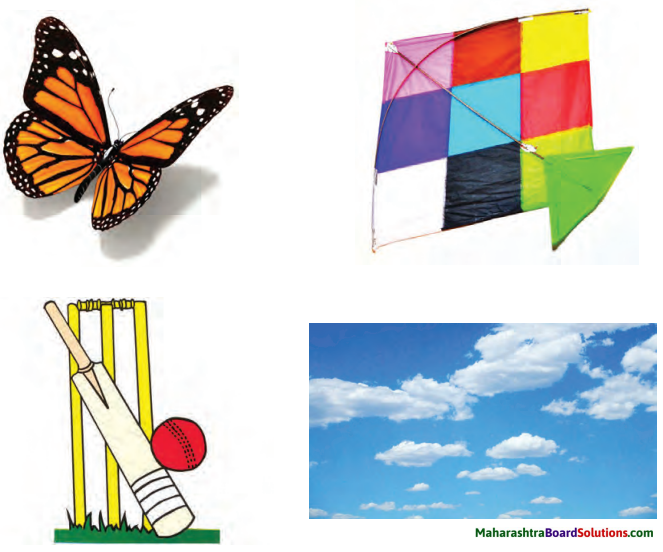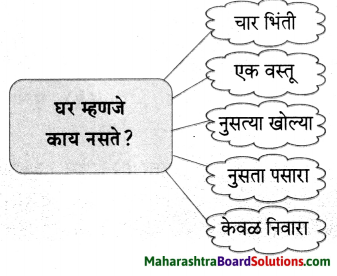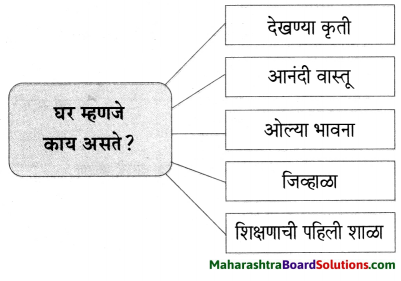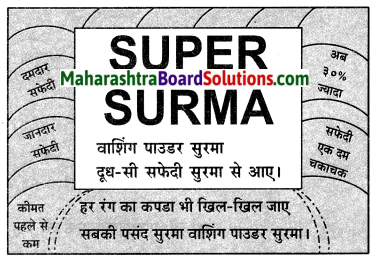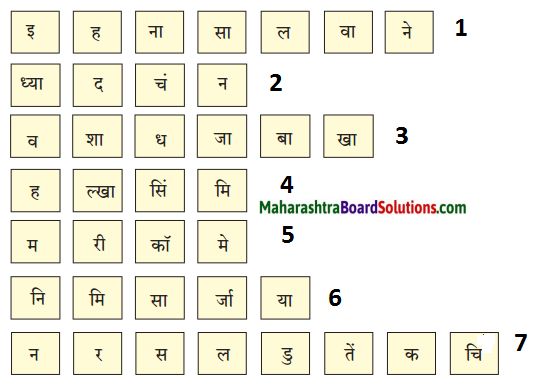Balbharti Maharashtra State Board Class 6 Marathi Solutions Sulabhbharati Chapter 4 माहिती घेऊया Notes, Textbook Exercise Important Questions and Answers.
Maharashtra State Board Class 6 Marathi Solutions Chapter 4 माहिती घेऊया
Marathi Sulabhbharti Class 6 Solutions Chapter 4 माहिती घेऊया Textbook Questions and Answers
1. भारतीय संशोधकांची नावे व त्यांनी लावलेले शोध यांची माहिती घेऊन तक्ता तयार करा. वर्गात लावा.
प्रश्न 1.
भारतीय संशोधकांची नावे व त्यांनी लावलेले शोध यांची माहिती घेऊन तक्ता तयार करा. वर्गात लावा.
उत्तर:
| भारतीय संशोधक | लावलेले शोध |
| 1. ए. पी. जे. अब्दुल कलाम | अग्नी, पृथ्वी, क्षेपणास्त्र स्वदेशी पद्धतीने बनवले |
| 2. जयंत विष्णू नारळीकर | ब्रहमांड उत्पत्ती शोध – बिग बँग थियरी |
| 3. विक्रम साराभाई | आण्विक उर्जा, इलेक्ट्रॉनिक्स |
| 4. डॉ. जगदीशचंद्र बोस | रेडीयो, सूक्ष्म तरंगांचे प्रकाशिकीवर कार्य |
| 5. डॉ. होमी जहांगीर भाभा | परमाणू उर्जा |
![]()
2. कोणकोणत्या गोष्टींमध्ये संशोधन व्हावे असे तुम्हांला वाटते? विचार करा व लिहा.
प्रश्न 1.
कोणकोणत्या गोष्टींमध्ये संशोधन व्हावे असे तुम्हांला वाटते? विचार करा व लिहा.
उत्तर:
- कॅन्सरच्या सर्व पातळ्यांवर
- अवयव प्रत्यारोपण
- थर्माकोल विघटन
- इलेक्ट्रॉनिक्स कचऱ्याची विल्हेवाट
![]()
3. खालील वाक्याचे वचन बदलून वाक्ये पुन्हा लिहा.
उदा., भिंत कोसळली – भिंती कोसळल्या.

उप्रकम: आंतरजालाचा उपयोग करून डॉ. वसंत गोवारीकर यांची माहिती मिळवा. कोलाज तयार करा.
प्रकल्प: वर्तमानपत्रात शास्त्रज्ञ, संशोधक यांच्याविषयी येणाऱ्या माहितीची कात्रणे काढून चिकटवही बनवा.
प्रश्न 1.
खालील वाक्याचे वचन बदलून वाक्ये पुन्हा लिहा.
उदा., भिंत कोसळली – भिंती कोसळल्या.

उत्तर:
| 1. मला कविता आठवली. | आम्हाला कविता आठवल्या. |
| 2. त्याने खुर्ची ठेवली. | त्यांनी खुर्ध्या ठेवल्या. |
| 3. मधू आंबा खा. | मधू आंबे खा. |
Marathi Sulabhbharti Class 6 Solutions Chapter 4 माहिती घेऊया Important Additional Questions and Answers
योग्य पर्याय निवडून उत्तरे लिहा.
- डॉ. वसंत गोवारीकरांचा जन्म …………… (25 मार्च, 1933, 25 मार्च 1923)
- त्यांनी पत्र पाठविले …………… (विक्रम साराभाईंना, हेन्री फोर्डला)
- डॉ. वसंत गोवारीकरांनी नवीन पद्धत शोधून काढली. ……………(मान्सूनच्या अंदाजाची, उर्जेची)
उत्तर:
- 25 मार्च 1933
- हेन्री फोर्डला
- मान्सूनच्या अंदाजाची
![]()
एका वाक्यात उत्तरे लिहा.
प्रश्न 1.
डॉ. वसंत गोवारीकरांचे पदवीपर्यंतचे शिक्षण कुठे झाले?
उत्तर:
डॉ. वसंत गोवारीकरांचे पदवीपर्यंतचे शिक्षण कोल्हापूरला झाले.
प्रश्न 2.
डॉ. वसंत गोवारीकरांनी कोणते तंत्र विकसित केले?
उत्तर:
डॉ. वसंत गोवारीकरांनी अग्निबाणाच्या मोटारीकरिता घन इंधन बनवण्याचे तंत्र विकसित केले.
प्रश्न 3.
देशभर कोणती चिंता असते?
उत्तर:
पाऊस केव्हा पडेल? किती पडेल? याची देशभर चिंता असते.
![]()
प्रश्न 4.
पत्राचे इंग्रजी भाषांतर करण्यासाठी गोवारीकरांनी कोणाची मदत घेतली?
उत्तर:
पत्राचे इंग्रजी भाषांतर करण्यासाठी गोवारीकरांनी मित्राची मदत घेतली.
प्रश्न 5.
गोवारीकरांचा कोणत्या दोन गुणांची चुणूक लहानपणीच दिसून आली?
उत्तर:
त्यांच्या कुशाग्र बुद्धिमत्तेची आणि दृढ संकल्पाची चुणूक लहानपणीच दिसून आली.
प्रश्न 6.
पदवीपर्यंतच्या शिक्षणानंतर गोवारीकर उच्च शिक्षणासाठी कुठे गेले?
उत्तर:
पदवीपर्यंतच्या शिक्षणानंतर गोवारीकर उच्च शिक्षणासाठी इंग्लंडला गेले.
प्रश्न 7.
कोणत्या विदयापीठात त्यांनी ‘रासायनिक अभियांत्रिकी’ विषयात संशोधन केले?
उत्तर:
बर्मिंगहॅम विद्यापीठात त्यांनी ‘रासायनिक अभियांत्रिकी’ विषयात संशोधन केले.
![]()
प्रश्न 8.
संशोधक म्हणून त्यांनी कोठे काम केले?
उत्तर:
इंग्लंडच्या उर्जा संशोधन केंद्रात संशोधक म्हणून काम केले.
खालील प्रश्नांची दोन-तीन वाक्यांत उत्तरे लिहा.
प्रश्न 1.
भारताच्या विज्ञान क्षेत्रातील डॉ. गोवारीकरांनी केलेली
कामगिरी लिहा.
उत्तर:
विक्रम साराभाईंच्या आग्रहामुळे 1967 साली ते भारताच्या अवकाश संशोधन केंद्रात रुजू झाले. ‘घन पदार्थातील उर्जा’ या विषयाच्या संशोधनासाठी त्यांच्या पुढाकाराने नवा प्रकल्प सुरू करण्यात आला. अग्निबाणाच्या मोटारीकरिता घन इंधन बनवण्याचे तंत्र त्यांनी विकसित केले. मान्सूनच्या अंदाजाची नवी पद्धत शोधून काढली.
![]()
प्रश्न 2.
शाळेत असताना त्यांना कोणती कल्पना सुचली? त्याची कशी दखल घेतली गेली?
उत्तर:
शाळेत असताना आपण मोटार बनवावी असे त्यांना वाटले. तेराव्या वर्षी त्यांनी अमेरिकेतील हेन्री फोर्डला पत्र लिहून आपली इच्छा कळवली. हेनरी फोर्डला मराठीतील पत्र कळणार नाही म्हणून मित्राच्या मदतीने पत्राचे इंग्रजी भाषांतर केले. हेन्री फोर्डने डॉ. गोवारीकरांच्या पत्राची दखल घेऊन उत्तरही पाठवले. सोबत काही पुस्तके पाठविली.
व्याकरण व भाषाभ्यास:
प्रश्न 1.
खालील वाक्यांचे वचन बदलून वाक्ये पुन्हा लिहा.
उदा. भिंत कोसळली – भिंती कोसळल्या
उत्तर:
| 1. मीराला पिशवी सापडली. | मीराला पिशव्या सापडल्या. |
| 2. रामने पुस्तक वाचले. | रामने पुस्तके वाचली. |
![]()
प्रश्न 2.
लिंग बदला.
- मित्र
- आजोबा
- भाऊ
- मुलगा
- मामा
- लेखक
- कवी
- समाजसेवक
- बाई
- नट
उत्तर:
- मैत्रिण
- आजी
- बहिण
- मुलगी
- मामी
- लेखिका
- कवयित्री
- समाजसेविका
- माणूस
- नटी
प्रश्न 3.
विरूद्धार्थी शब्द लिहा.
- दूर
- नवी
- मित्र
- कुशाग्र
- दृढ
- मोठी
- विकसित
- घन
उत्तर:
- जवळ
- जुनी
- शत्रू
- मंद
- डळमळीत
- छोटी, लहान
- अविकसित
- द्रव
![]()
प्रश्न 4
खालील वाक्प्रचारांचा वाक्यात उपयोग करा.
उत्तर:
- विकसित करणे – शेतकऱ्यांनी संत्रांचा वापर करून शेती विकसित केली.
- रुजू होणे – बरेच दिवसांच्या सुट्टीनंतर रमेश कामावर रुजू झाला.
लेखन विभाग:
प्रश्न 1.
आंतरजालाचा उपयोग करून डॉ. वसंत गोवारीकर यांची माहिती मिळवा.
उत्तर:
डॉ. वसंत रणछोड गोवारीकर यांचा जन्म 25 मार्च 1933 रोजी झाला. एक भारतीय शास्त्रज्ञ म्हणून त्यांचा नावलौकिक आहे. इंडियन स्पेस रिसर्च ऑर्गनायझेशन मध्ये ते मुख्य पदावर विराजमान होते. अंतराळ, हवामान, लोकसंख्या विषयांवरचे त्यांचे योगदान महत्त्वपूर्ण आहे. पद्मश्री व पद्मभूषण या पुरस्करांनी त्यांना सन्मानित केले गेले. 2 जानेवारी 2015 रोजी ते अनंतात विलीन झाले.
माहिती घेऊया Summary in Marathi
पाठ परिचयः
पद्मश्री व पद्मभूषण पुरस्कार प्राप्त असलेले श्री. वसंत गोवारीकर एक भारतीय संशोधक होते. अवकाश संशोधनाच्या मुख्य पदावर कार्यरत असलेले वसंत गोवारीकर 1991 – 1993 च्या काळात पंतप्रधानांचे सल्लागारही होते. अंतराळ संशोधन, हवामान, लोकसंख्या या विविध विषयांवरचे त्यांचे योगदान अमूल्य आहे. प्रस्तुत पाठात त्यांच्याविषयी अधिक माहिती जाणून घेता येईल.
![]()
शब्दर्थ:
- देश – राष्ट्र (nation)
- चिंता – काळजी (worry)
- शोधणे – हुडकून काढणे (to invent)
- कल्पना – युक्ती (idea)
- भाषांतर – एका भाषेतून दुसऱ्या भाषेत लिहिणे. (translation)
- थेट – सरळ (direct)
- कुशाग्र – तीक्ष्ण (sharp)
- संकल्प – figale (resolution)
- संशोधन – नवीन शोध (invention)
- प्रकल्प – योजना (project)
- क्षेत्र – विभाग (field, area)
- कामगिरी – कार्यवाही (execution of work)
- इंधन – जळाऊ पदार्थ (fuel)
- विकसित करणे – वाढविणे (to develop)
- घन – कठीण (solid)
- चुणूक – झलक (a faint indication)





